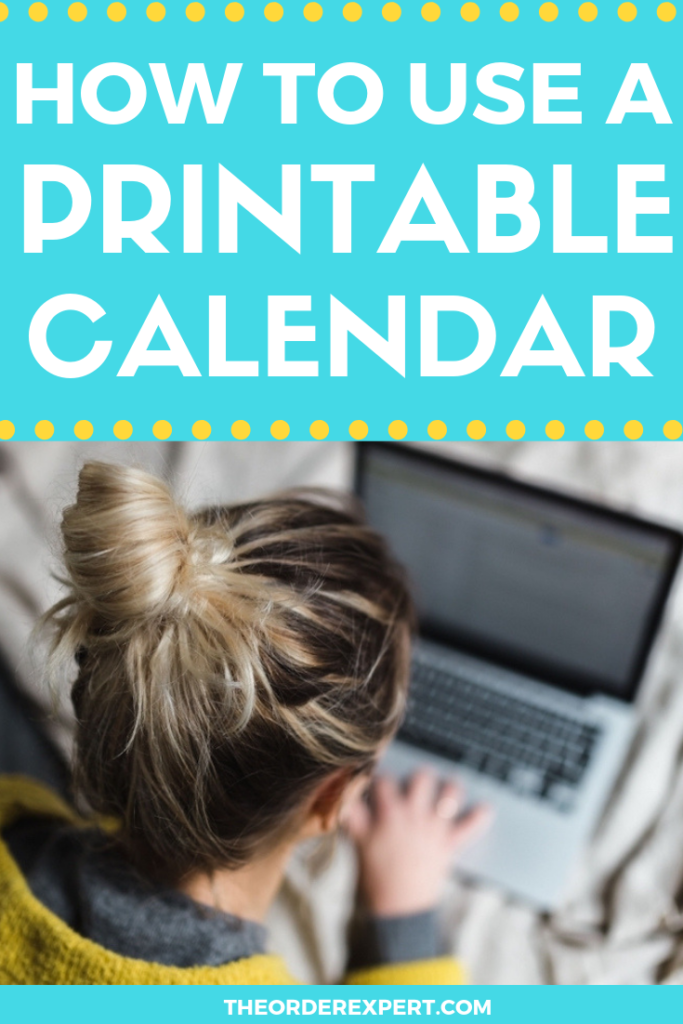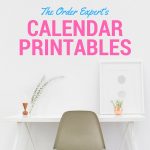
Do you need help planning your schedule with a printable calendar?
Are you looking for a simple way to layout and organize items in a pinch?
Printable calendars offer an easy and instant way for you to plan your days, weeks, and months.
While we traditionally think of physical calendars as picturesque monthly hanging calendars, witty desk calendars, or extra large wall calendars, there’s something to be said for using printable calendars.
Printable calendars offer a bit more flexibility and customization than pre-fabricated calendars.
You can also print calendars on-demand and assemble them as you so desire.
In this post, you’ll find several tips to help you use a printable calendar for your needs.
Whether you use printable calendars every once in a while, or every day, you’ll find some helpful tips to assist you in your planning.
Are you ready to get the scheduling process started?
Let’s begin!
If you want to create and customize your very own printable calendars, check out my printable calendar collection.
Printable Calendars: Practical and Effective
Okay, so you’re interested in using a printable calendar.
You’ve obviously got some planning ideas floating around your mind, but have you ever considered some of the more practical uses for a printable calendar?
Here are four practical reasons to use a printable calendar:
You can create and view various calendar options at a glance.
One benefit in using printable calendars is that you can use them to create different versions of a schedule.
This is especially useful for those times when you are still trying out various combinations and permutations and are not yet married to a particular schedule.
You can write up different versions of a schedule and then layout and compare versions side-by-side on a large table or affixed to a wall or bulletin board.
What’s more, you can even mix, match, and integrate different pieces of schedules to find the optimal combination for your needs.
You have a tactile and visual aid.
As convenient as digital calendars and planners are, there’s something to be said for having a physical calendar at your fingertips.
For some people, seeing and holding a physical calendar has more staying power than a digital file or document.
You can hold a calendar in your hands, see it sitting on a desk or wall, and make edits with a pencil, which is far more interactive than glancing at text on a screen.
You can work without technology.
For those looking to focus completely on their work without being interrupted by pinging alerts and dinging updates by digital devices, printable calendars offer some respite.
Nowadays, we have to work hard to protect our time; even the time spent planning!
Using a printable calendar allows you to focus solely on the task at hand to plan out your days, weeks, months, and even years.
You only need a calendar for a brief period of time.
Working on a project or assignment that only lasts a few days, weeks, or months?
Instead of buying a calendar for an entire year (and then figuring out how you’re going to use the calendar for the rest of the year) you can create a customized calendar to specifically meet your needs.
Another bonus is that you can store the calendar amongst your notes, papers, and files as you use it, and afterwards, too.
How to Use a Printable Calendar
Using a printable calendar effectively requires careful thought.
Here are some smart tips to help you use a printable calendar effectively:
Consider the duration of your calendar’s usage.
The first thing to consider when using a printable calendar is the duration or length of time for which you’ll use your calendar.
Is your project or assignment a short one, such as a few days or weeks? Or is it something that will take a longer period of time such as several months, a year, or more?
If you have a short project or assignment, you might want to have a daily or weekly calendar. If you have a longer project or assignment, you may want to use a weekly or monthly calendar.
Depending on the complexity of your project, you may even choose to use a combination of daily, weekly, or monthly calendars for both up-close and bird’s eye views.
Identify the format that best suits your needs.
After you’ve identified the length or general length of time you’ll need for your calendar the next step is to find a format that best suits your needs.
Formats make a huge difference when it comes to planning because they can help you better visualize and structure your days, according to your needs.
If you haven’t considered formats when it comes to planning or your planning, you really should consider it and see how it affects your planning and visualizing for future events!
Related to this is the amount of content you are going to add to your calendar.
If you need a bare bones calendar for a general topic, you probably won’t need a lot of open space or lines for calendar entries.
But, if you need to record and keep track of more detailed information, you’ll probably want more room in which to write.
Below are some popular types of calendar formats, including ways you can use them, and who might benefit from a particular format.
Daily Formats
Daily Schedule Calendar
Features: This type of calendar format allows to you prepare a detailed schedule and keep track of relevant items such as daily to-dos and notes. This calendar format can be helpful if you need to track appointments and meetings, and have your to-dos and notes at your fingertips.
Who might benefit from using this type of calendar:
- Those who have regular daily appointments and meetings
- Those who are working on deadlines for home, work, or school
- Those who like to focus on daily work by having their schedule, to-dos, and notes in one place
Daily Morning/Afternoon/Evening Calendar
Features: This type of calendar format allows you to enter schedule information into three broad sections: morning, afternoon, and evening. This calendar format can be helpful if you’re looking for a general reference for your daily activities.
Who might benefit from using this type of calendar:
- Those who want a quick at-a-glance daily reference
- Those who want to built a daily habit or habits throughout the day
- Those who have a relatively light calendar when it comes to scheduling
Daily Blank Calendar
Features: This type of calendar format allows you to create your very own calendar format as needed on a daily basis. This freeform calendar format acts as a holding place for the days of the week so you can add detailed or general information as you so wish.
Who might benefit from using this type of calendar:
- Those who want to design their own daily calendar subheadings and entries
- Those who enjoy having flexibility in their daily entries
- Those who want to keep a daily journal or notebook record
Weekly Formats
Weekly Grid Calendar
Features: This type of calendar format is perfect for blocking out large chunks of time during the week across a time axis. This calendar format allows you to easily compare daily timelines against one another.
Who might benefit from using this type of calendar:
- Those who work on a shift schedule and/or one with varying times throughout the week
- Those who want to visualize their workflow and projects for the week
- Those who want a visual weekly snapshot of how they are spending their time
Weekly Portrait Calendar
Features: This type of calendar format allows you to write in general entries for each day. This calendar format allows you to track the general tone and progress of your week’s activities.
Who might benefit from using this type of calendar:
- Those who want to keep track of general activities for each day of the week
- Those who want to built a daily habit or habits throughout the day
- Those who have a relatively light calendar when it comes to scheduling
Weekly Schedule Calendar
Features: This type of calendar format allows you to schedule calendar items for each day of the week. This calendar format makes it easy to compare a week’s worth of daily schedules, side-by-side.
Who might benefit from using this type of calendar:
- Those who have regular daily appointments and meetings
- Those who are working on deadlines for home, work, or school
- Those who like to have a sneak peek of calendar items during the week
Weekly Blank Calendar
Features: This type of calendar format allows you to create your very own calendar format as needed on a weekly basis. Like the Daily Blank Calendar, this freeform calendar format acts as a holding place for the days of the week so you can add detailed or general information as you so wish.
Who might benefit from using this type of calendar:
- Those who want to design their own weekly calendar subheadings and entries
- Those who enjoy having flexibility in their weekly entries
- Those who want to keep a weekly journal or notebook record
Monthly Formats
Monthly Blank Calendar
Features: This type of calendar format allows you plan monthly activities, projects, assignments, tasks, and to-dos. This calendar format sometimes includes monthly goal, to-do, and note sections.
Who might benefit from using this type of calendar:
- Those who want to visualize their workflow and projects for the month
- Those who are working on deadlines for home, work, or school
- Those who like to have a sneak peek of calendar items during the month
Monthly Quad Blank Calendar
Features: This type of calendar format allows you plan and compare monthly activities, projects, assignments, tasks, and to-dos against subsequent months of the year. This calendar format sometimes includes monthly goal, to-do, and note sections.
Who might benefit from using this type of calendar:
- Those who want to visualize their workflow and projects for the quarter or next several months
- Those who are working on deadlines for home, work, or school
- Those who like to have a sneak peek of upcoming calendar items throughout the year
Monthly Portrait Side-by-Side Calendar
Features: This type of calendar format allows you plan and compare monthly activities, projects, assignments, tasks, and to-dos against a neighboring month of the year. This calendar format sometimes includes monthly goal, to-do, and note sections.
Who might benefit from using this type of calendar:
- Those who want to visualize their workflow and projects for this and the following month
- Those who are working on deadlines for home, work, or school
- Those who like to have a sneak peek of upcoming calendar items
Enter calendar entries with care.
You’ve selected and printed your preferred printable calendar. Now what? Well, you’ll want to enter in calendar entries with care.
You can start by rounding up relevant information for your calendar such as gathering related paperwork, opening up an email, consulting a flyer or mailing, or simply jotting down ideas about what you’d like to include in your calendar on some scratch paper.
Next, you’ll want to have some of your favorite office supplies on hand to help you enter information into your calendar.
You can use different color pen inks, pencil leads, or markers, and use cursive, print, or block lettering to write in and emphasize different aspects of your calendar, such as tasks, events, meetings, activities, and appointments.
You can also use supplies like ink stamps, stickers, decorative tape, and sticky notes to add a more personal touch.
Stumped when it comes to ideas for using a printable calendar?
Here are some ideas to get you started:
Household ideas
- Meal planning calendar
- Household chore calendar
- Spring cleaning calendar
- Decluttering calendar
- Home maintenance calendar
- Yard work calendar
- Gardening calendar
- Birthday calendar
- Event planning or party planning tracker
Financial ideas
- Bill paying calendar
- Savings calendar
- Budget calendar
Work and school ideas
- Work or shift calendar
- Meeting calendar
- Office holiday calendar
- School holiday calendar
- Study calendar
- Assignment and examination calendar
- Volunteer shift calendar
- Vacation calendar
Health and wellness ideas
- Weight tracker calendar
- Water intake tracker calendar
- Exercise tracker calendar
- Healthy food tracker calendar
- Blood pressure tracker calendar
- Medicine tracker calendar
- Doctor’s appointment calendar
Personal development ideas
- Reading calendar
- Writing calendar
- Meditation calendar
- Religious calendar
- Relaxation calendar
- Hobby calendar
You may also want to check out my blog posts, 40 Things to Schedule into Your Calendar and 19 Fun Things to Put on a Calendar.
Store your calendar in a safe location.
Creating a schedule from scratch is a lot of work. The last thing you want to happen is to lose all of your hard work!
You may be using your calendar everyday, in which you’ll need to access the contents quickly or easily, or you may use your calendar on a more sporadic basis, such as every few weeks or months.
Regardless of when you’ll use your calendar, you’ll want to find it without fuss or frustration. Take a moment to think about where you’ll store your printable calendar.
Your calendar should be located in a place that is closely related to your work. For example, you probably would want to keep a meal plan or schedule in the kitchen, as opposed to the bedroom.
Here are some storage ideas for your printable calendar:
- Place in a clear plastic sheet protector in a three-ring binder
- Use magnets or cellophane tape to affix to the exterior of a refrigerator
- Use sticky tack to affix to the back of an office door or near a light switch
- Use thumbtacks to affix to a bulletin board
- Tape to a whiteboard or blackboard
- Fold and staple into a notebook or journal
- Fold and tuck away in the front or back pocket of a portable planner or calendar
- Laminate and tape or affix to a desk top or countertop
- Fold and tape/staple to a manila file folder
- Tape or staple to the outside of a flat document envelope
Review your calendar on a regular basis.
Once you’ve properly stored your calendar, you’ll want to make a plan to review the contents on a regular basis. What’s the point in taking the time to develop a calendar or schedule if you’re not going to consult your creation?
Creating a calendar review strategy is simple: you decide when and how you’re going to review the calendar.
When are you going to review your calendar? You’ll want to make sure your calendar review supports your daily, weekly, and monthly actions. Ideally, you should review your calendar before you set out on your next set of routines, practices, errands, or actions.
Here’s an example for you: if you created an exercise routine calendar for yourself, you’ll want to refer to the calendar *before* you head to the gym for your workout.
Time of day also has a bearing on when you’ll review your calendar: if you work out early in the morning, you’ll want to review your calendar the night before or before you work out, conversely, if you work out in the afternoon or evening hours, you’ll want to accordingly review your calendar later in the day before you workout.
So, will you check your calendar first thing in the morning after you wake, at the beginning of the work day, or in the evening at home? How about at the end of the work week, beginning of the school week, start of the new month?
The next part in reviewing your calendar, the how, is a little bit different. You’re going to note your progress and make plans for the future. Simply glancing at your calendar isn’t enough.
You’ll want to a) note your progress, b) identify challenges that hindered your progress since your last calendar review, and c) create a plan to help you move forward with your schedule.
If you feel you’re not reviewing your calendar on a regular basis, you may want to create a reminder for yourself to check your calendar.
This can be as simple as writing down a reminder in a frequently used planner, journal, or notebook, or creating a reminder alert on your smartphone app.
You may also want to consider relocating your calendar to a more visible location so you’re less likely to miss it.
If you want to create and customize your very own printable calendars, check out my printable calendar collection.
How about you? What are some ways you’ve used printable calendars? How are you going to use printable calendars in future? Join the conversation and leave a comment below!






0 Comments